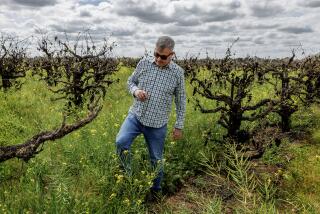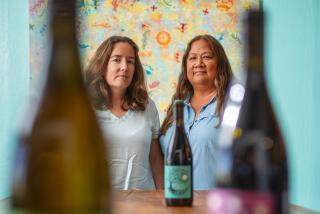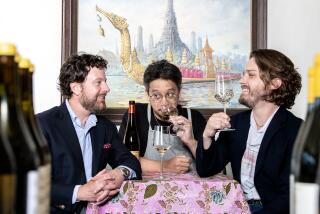‘Fighting Varietals’ : Inexpensive Italian Wines May Shock and Please Californians
THE FIRSTwave of “fighting varietals” from overseas has hit the West Coast.
“Fighting varietals” are Chardonnays and Cabernets that typically sell for less than $5 a bottle. The term is generally credited to the late J. Bruno Benziger, a tough ex-Marine, of Glen Ellen Winery in Sonoma, because he produced good inexpensive varietals several years ago. He had bought excess inventories of Chardonnays and Cabernets from different California wineries, blended them and sold them as “Proprietor’s Reserve” wines under the Glen Ellen label.
Inexpensive varietals are nothing new, but they were lacking in prestige. That prestige came with the Glen Ellen “Proprietor’s Reserve” label. And as interest in producing inexpensive varietals spread, more expensive varietals were faced with a challenge.
One such challenge has come from Torresella of Veneto, Italy. Torresella’s varietal wines are light and fruity, which may shock and surprise California wine drinkers. None of the Torresella wines touch wood, unlike California varietals, which, in the main, are fermented and aged in oak. Torresella has been popular in New York and southern Florida, and it hopes to duplicate its success on the West Coast.
“Our philosophy is to produce everyday, affordable high-quality varietal wines,” says Alberto Fantin, Torresella export manager, with whom I recently tasted the wines.
The Torresella vineyards and four wineries are between Venice and Trieste in northeastern Italy, an area noted for wines since the days of the Romans. Torresella, meaning small tower , is named for the ruins of a medieval castle that stood until 1639 in the midst of what is today’s Torresella vineyards.
The wineries are the heart of an agricultural estate created in 1935 by a highly successful textile magnate, Count Gaetano Marzotto. Some 30 years ago, to help the farmers, the count sold about 4,000 acres of vineyards to 35 farmers, with the agreement that he would buy the grapes if the farmers grew them.
The five Torresella wines, Sauvignon Blanc, Chardonnay, Pinot Grigio, Merlot and Cabernet, each 100% of that grape variety, are fermented in temperature-controlled stainless-steel tanks, and aged in glass-lined tanks, never in wood. These methods result in lighter and fruitier table wines, which is consistent with the trend toward lighter dining.
Torresella wines are a bargain discovery. But these are not, repeat not , in the style of California’s elegant varietals, which are expensively aged in fine French oak. Torresella wines are for present consumption. They are not intended for aging. They are inexpensive, quaffable wines, worthy of daily table service; they will make fine additions to any Labor Day picnic.
Current releases are:
Torresella 1987 Sauvignon Blanc ($4.99) has a low-level bouquet with slight grassiness. It is pale, almost silvery. This wine is recommended to accompany appetizers or salads.
Torresella 1987 Chardonnay ($4.99) is light-bodied, crisp, clean, fresh, deliberately light. This wine may astound California Chardonnay palates because there is no oak to modify the fruit taste. Serve with seafood dishes.
Torresella 1987 Pinot Grigio ($4.99) is equally light and well-balanced. It has some varietal character and surprising finesse. Clean competition to many white California jug wines.
Torresella 1986 Merlot ($4.99). This drinkable, slightly herbaceous ruby-red wine benefits from chilling. It is a good companion for open-air barbecues and spit-roasted meats.
Torresella 1986 Cabernet ($4.99) does not present as much varietal identification as Californians might expect in bouquet and body. This Cabernet is lighter and has a negligible bouquet, while a California Cabernet has a more robust bouquet. This smooth, simple red table wine has an exquisite ruby clarity. Try with grilled meats and cheeses.
These varietals should be easy to find at your wine shop. The bottles are beautifully labeled with depictions of endangered birds from the Venetian countryside. The label alone is worth the price of the bottle. But it doesn’t hurt that the contents are very drinkable.
More to Read
Eat your way across L.A.
Get our weekly Tasting Notes newsletter for reviews, news and more.
You may occasionally receive promotional content from the Los Angeles Times.









